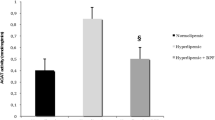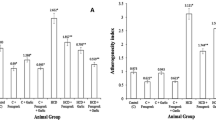Abstract
Cholesterolemia is associated with pro-oxidative and proinflammatory effects. Glucomannan- or glucomannan plus spirulina-enriched surimis were included in cholesterol-enriched high-saturated diets to test the effects on lipemia; antioxidant status (glutathione status, and antioxidant enzymatic levels, expressions and activities); and inflammation biomarkers (endothelial nitric oxide synthase (eNOS), inducible nitric oxide synthase (iNOS), tumor necrosis factor alpha (TNF-α)) in Zucker fa/fa rats. Groups of eight rats each received diet containing squid-surimi (C), squid-surimi cholesterol-enriched diet (HC), glucomannan-squid-surimi cholesterol-enriched diet (HG), or glucomannan-spirulina-squid-surimi cholesterol-enriched diet (HGS) over a period of 7 weeks. HC diet induced severe hyperlipemia, hepatomegalia, increased inflammation markers, and impaired antioxidant status significantly (at least p < 0.05) vs. C diet. HG diet decreased lipemia and liver size and normalized antioxidant status to C group levels, but increased TNF-α with respect to HC diet (p < 0.05). In general terms, 3 g/kg of spirulina in diet maintained the positive results observed in the HG diet but, in addition, increased inflammation index [eNOS/(eNOS + iNOS)] and decreased plasma TNF-α (both p < 0.05). In conclusion, glucomannan plus a small amount of spirulina blocks negative effects promoted by hypercholesterolemic diets. Although more studies are needed, present results suggest the utility of including glucomannan and/or spirulina as functional ingredients into fish derivates to be consumed by people on metabolic syndrome risk.



Similar content being viewed by others
Abbreviations
- CAT:
-
Catalase
- eNOS:
-
Endothelial nitric oxide synthase
- GPx:
-
Glutathione peroxidase
- GR:
-
Glutathione reductase
- GSH:
-
Reduced glutathione
- GSSG:
-
Oxidized glutathione
- iNOS:
-
Inducible nitric oxide synthase
- RNS:
-
Reactive nitrogen species
- ROS:
-
Reactive oxygen species
- SOD:
-
Superoxide dismutase
- TNF-α:
-
Tumor necrosis factor alpha
References
Aebi H (1984) Catalase in vitro. Method Enzymol 105:121–126
Aguirre L, Hijona E, Macarulla MT, Gracia A, Larrechi I, Bujanda L, Hijona L, Portillo MP (2013) Several statins increase body and liver fat accumulation in a model of metabolic syndrome. J Physiol Pharmacol 64:281–288
Arai S, Osawa T, Ohigashi H, Yoshikawa M, Kaminogawa S, Watanabe M, Ogawa T, Okubo K, Watanabe S, Nishino H, Shinohara K, Esashi T, Hirahara T (2001) A mainstay of functional food science in Japan: history, present status, and future outlook. Biosci Biotech Bioch 65:1–13
Bocanegra A, Benedí J, Sánchez-Muniz FJ (2006) Differential effects of konbu and nori seaweed dietary supplementation on liver glutathione status in normo- and hypercholesterolaemic growing rats. Br J Nutr 95:696–702
Bondia-Pons I, Ryan L, Martínez JA (2012) Oxidative stress and inflammation interactions in human obesity. J Physiol Biochem 68:701–711
Borderías A, Sánchez-Alonso I, Pérez-Mateos M (2005) New applications of fibres in foods: addition to fishery products. Trends Food Sci Tech 16:458–465
Bradford M (1976) A rapid and sensitive method for the quantitation of microgram quantities of protein utilizing the principle of protein-dye binding. Anal Biochem 72:248–254
Brockman D, Chen X, Gallaher D (2012) Hydroxypropyl methylcellulose, a viscous soluble fiber, reduces insulin resistance and decreases fatty liver in Zucker diabetic fatty rats. Nutr Metab 9:100
Codoñer-Franch P, Valls-Bellés V, Arilla-Codoñer Á, Alonso-Iglesias E (2011) Oxidant mechanisms in childhood obesity: the link between inflammation and oxidative stress. Transl Res 158:369–384
Fernández-Villaverde A, Benlloch S, Berenguer M, Miguel-Rayón J, Pina R, Berenguer J (2004) Acute hepatitis of cholestatic type possibly associated with the use of glucomannan (Amorphophalus konjac). J Hepatol 41:1061–1067
González-Canga A, Fernández-Martínez N, Sahagún AM, García-Vieitez JJ, Diez-Liébana MJ, Calle-Pardo AP, Castro-Robles LJ, Sierra-Vega M (2004) Glucomanano: propiedades y aplicaciones terapéuticas. Nutr Hosp 19:45–50
González-Torres L, Churruca I, Schultz Moreira AR, Bastida S, Benedí J, Portillo MP, Sánchez-Muniz FJ (2012) Effects of restructured pork containing Himanthalia elongata on adipose tissue lipogenic and lipolytic enzyme expression of normo- and hypercholesterolemic rats. J Nutrigenet Nutrigenomics 5:158–167
Hissin P, Hill R (1976) Fluorimetric method for determination of oxidized and reduced glutathione in tissues. Anal Biochem 74:214–226
Irizar A, Barnett CR, Flatt PR, Ioannides C (1995) Defective expression of cytochrome P450 proteins in the liver of the genetically obese Zucker rat. Eur J Pharmacol 293:385–393
Kris-Etherton P, Harris W, Appel LJ (2003) Fish consumption, fish oil, omega-3 fatty acids, and cardiovascular disease. Arterioscler Thromb Vasc Biol 23:20–30
Lawrence R, Burk R (1976) Glutathione peroxidase activity in selenium-deficient rat liver. Biochem Biophys Res Commun 71:952–958
Lecumberri E, Mateos R, Ramos S, Alia M, Rupérez P, Goya L, Izquierdo-Pulido M, Bravo L (2006) Characterization of cocoa fiber and its effect on the antioxidant capacity of serum in rats. Nutr Hosp 21:622–628
Livak K, Schmittgen T (2001) Analysis of relative gene expression data using real-time quantitative PCR and the 2(−Delta Delta C(T)) method. Methods 25:402–408
Lorente-Cebrián S, Costa AG, Navas-Carretero S, Zabala M, Laiglesia LM, Martínez JA, Moreno-Aliaga MJ (2015) An update on the role of omega-3 fatty acids on inflammatory and degenerative diseases. J Physiol Biochem 71:341–349
Marklund SL (1985) Pyrogallol oxidation. In: Greenwald R (ed) Handbook of methods for oxygen radical research. CRC Press, Boca Raton, pp 243–247
Martínez JA (2006) Mitochondrial oxidative stress and inflammation: an slalom to obesity and insulin resistance. J Physiol Biochem 62:303–306
Mells JE, Fu PP, Kumar P, Smith T, Karpen SJ, Anania FA (2015) Saturated fat and cholesterol are critical to inducing murine metabolic syndrome with robust nonalcoholic steatohepatitis. J Nutr Biochem 26:285–292
Nagaoka S, Shimizu K, Kaneko H, Shibayama F, Morikawa K, Kanamaru Y, Otsuka A, Hirahashi T, Kato T (2005) A novel protein C-phycocyanin plays a crucial role in the hypocholesterolemic action of Spirulina platensis concentrate in rats. J Nutr 135:2425–2430
Paglia D, Valentine W (1967) Studies on the quantitative and qualitative characterization of erythrocyte glutathione peroxidase. J Lab Clin Med 70:158–169
Plaza-Diaz J, Gomez-Llorente C, Abadia-Molina F, Saez-Lara MJ, Campaña-Martin L, Muñoz-Quezada S, Romero F, Gil A, Fontana L (2014) Effects of Lactobacillus paracasei CNCM I-4034, Bifidobacterium breve CNCM I-4035 and Lactobacillusrhamnosus CNCM I-4036 on hepatic steatosis in Zucker rats. PLoS One 9:e98401
Raju J, Bird RP (2006) Alleviation of hepatic steatosis accompanied by modulation of plasma and liver TNF-a levels by Trigonella foenum graecum (fenugreek) seeds in Zucker obese (fa/fa) rats. Int J Obes 30:1298–1307
Sánchez-Muniz FJ, Bastida S (2008) Do not use the Friedewald formula to calculate LDL-cholesterol in hypercholesterolaemic rats. Eur J Lipid Sci Technol 110:295–301
Schultz-Moreira A, Benedí J, González-Torres L, Olivero-David R, Bastida S, Sánchez-Reus MI, González-Muñoz MJ, Sánchez-Muniz FJ (2011) Effects of diet enriched with restructured meats, containing Himanthalia elongata, on hypercholesterolaemic induction, CYP7A1 expression and antioxidant enzyme activity and expression in growing rats. Food Chem 129:1623–1630
Shinkyo R, Guengerich F (2011) Cytochrome P450 7A1 cholesterol 7alpha-hydroxylation: individual reaction steps in the catalytic cycle and rate-limiting ferric iron reduction. J Biol Chem 286:4632–4643
Stokes KY, Cooper D, Tailor A, Granger DN (2002) Hypercholesterolemia promotes inflammation and microvascular dysfunction: role of nitric oxide and superoxide. Free Rad Biol Med 33:1026–1036
Stuehr D (1999) Mammalian nitric oxide synthases. Biochim Biophys Acta 1411:217–230
Tousoulis D, Kampoli A, Tentolouris C, Papageorgiou N, Stefanadis C (2012) The role of nitric oxide on endothelial function. Curr Vasc Pharmacol 10:4–18
Vázquez-Velasco M, González-Torres L, López-Gasco P, Bastida S, Benedí J, Sánchez-Reus MI, González-Muñoz MJ, Sánchez-Muniz FJ (2014) Liver oxidation and inflammation in fa/fa rats fed glucomannan/spirulina-surimi. Food Chem 159:215–221
Winiarska K, Focht D, Sierakowski B, Lewandowski K, Orlowska M, Usarek M (2014) NADPH oxidase inhibitor, apocynin, improves renal glutathione status in Zucker diabetic fatty rats: a comparison with melatonin. Chem Biol Interact 218:12–19
Zheng J, Inoguchi T, Sasaki S, Maeda Y, McCarty MF, Fujii M, Ikeda N, Kobayashi K, Sonoda N, Takayanagi R (2013) Phycocyanin and phycocyanobilin from Spirulina platensis protect against diabetic nephropathy by inhibiting oxidative stress. Am J Physiol Regul Integr Comp Physiol 304:110–120
Acknowledgments
The present study was supported by the Spanish projects AGL-2011-29644-C02-02, AGL-2008-04892-C03-02 and Consolider-Ingenio 2010 project # CSD2007-00016. We gratefully acknowledge the foreign fellowship for graduate studies granted by the Consejo Nacional de Ciencia y Tecnología (CONACYT) of México to Laura González-Torres.
Author’s contributions
All authors have significantly contributed to the paper and agree with the present version of the manuscript. FJ S-M is the corresponding author and guarantor of the paper, M V-V has contributed to the study design, data discussion, and writing of the paper, L G-T and P L-G have contributed to the data acquisition and analysis and writing of the paper. S B, J B, and MJ G-M have contributed to data discussion and have made a critical review of the paper.
Compliance with ethical standards
The present study was approved by the Spanish Science and Technology Advisory Committee (project AGL-2008-04892-C03-02) and by an ethics committee of the Universidad Complutense de Madrid (Spain). All experiments were performed in compliance with Directive 86/609/EEC of November 24, 1986 for the protection of scientific research animals.
Conflict of interest
The authors declare that they have no competing interests.
Author information
Authors and Affiliations
Corresponding author
Additional information
Miguel Vázquez-Velasco and Laura González-Torres are the first authors of this study.
Rights and permissions
About this article
Cite this article
Vázquez-Velasco, M., González-Torres, L., López-Gasco, P. et al. Effects of glucomannan/spirulina-surimi on liver oxidation and inflammation in Zucker rats fed atherogenic diets. J Physiol Biochem 71, 611–622 (2015). https://doi.org/10.1007/s13105-015-0425-9
Received:
Accepted:
Published:
Issue Date:
DOI: https://doi.org/10.1007/s13105-015-0425-9




